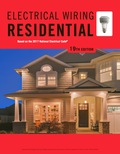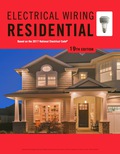
EBK ELECTRICAL WIRING RESIDENTIAL
19th Edition
ISBN: 9781337516549
Author: Simmons
Publisher: CENGAGE LEARNING - CONSIGNMENT
expand_more
expand_more
format_list_bulleted
Concept explainers
Question
thumb_up100%
Chapter 23.2, Problem 2R
To determine
Calculate the maximum total load capacity of a cord with respect to a separate branch circuit.
Expert Solution & Answer
Trending nowThis is a popular solution!

Students have asked these similar questions
I have a problem getting the time domain of system S, can you plz show me from where I should start until find the time domain equation of the system to transfer it to z-domain.
Q5
Q47
Chapter 23 Solutions
EBK ELECTRICAL WIRING RESIDENTIAL
Ch. 23.1 - a. What is the allowance in watts made for...Ch. 23.1 - What are some of the advantages of electric...Ch. 23.1 - List the different types of electric heating...Ch. 23.1 - There are two basic voltage classifications for...Ch. 23.1 - What device is required when the total connected...Ch. 23.1 - Prob. 6RCh. 23.1 - Prob. 7RCh. 23.1 - A certain type of control connects electric...Ch. 23.1 - What advantages does a 240-volt heating unit have...Ch. 23.1 - The white wire of a cable may be used to connect...
Ch. 23.1 - Receptacle outlets furnished as part of a...Ch. 23.1 - The branch circuit supplying a fixed electric...Ch. 23.1 - Prob. 13RCh. 23.1 - For ballpark calculations, the wattage output of a...Ch. 23.1 - A central electric furnace heating system is...Ch. 23.1 - What section of the Code provides the correct...Ch. 23.1 - Electric heating cable embedded in plaster, or...Ch. 23.2 - Prob. 1RCh. 23.2 - Prob. 2RCh. 23.2 - Prob. 3RCh. 23.2 - a. Must an air conditioner installed in a window...Ch. 23.2 - Prob. 5RCh. 23.2 - What is the Code requirement for receptacles...Ch. 23.2 - Prob. 7RCh. 23.2 - When the nameplate on an air-conditioning unit...Ch. 23.2 - Prob. 9RCh. 23.2 - Match the following terms with the statement that...Ch. 23.2 - The disconnect for an air conditioner or heat pump...
Knowledge Booster
Learn more about
Need a deep-dive on the concept behind this application? Look no further. Learn more about this topic, electrical-engineering and related others by exploring similar questions and additional content below.Similar questions
- Q1arrow_forwardQ3arrow_forwardGiven the logic function F(A,B,C,D) = Σm(1,2,3,4,9,10,11,12) (i) Write the truth table of the logic function. (ii) Use the Karnaugh-map method to find the simplest sum-of-products (SOP) expression of function F. (iii) Implement the minimized function with NAND gates only. (iv) Show that the Boolean function F can be constructed using exclusive-OR gates (v) Express the same logic function in a product-of-sums (POS) form. (vi) Simplify your function in product-of-sums (POS). (vii) Use a decoder with external AND gates only to implement F in its product-of- sums (POS) form (assume AND gates with any number of inputs are available). Note: You can use NAND gates with any number of inputs you may need. Assume, as well, that the input variables are available in both true and complemented form.arrow_forward
- Problem A medical research facility is developing a proton accelerator for cancer treatment using proton therapy. The accelerator is designed to generate a beam of protons that precisely targets and destroys cancerous cells while minimizing damage to surrounding healthy tissue. However, there is an issue with the beam trajectory, which deviates from the intended direction when subjected to electric and magnetic fields. A team of engineers has been assigned to diagnose and resolve this issue. -The accelerator generates a beam of 10" protons with an initial velocity of v = 3 × 10° m/s in the y-axis direction. -An electric field of E = 200 kV/m is applied in the negative z-axis using a set of electrodes. -A magnetic field of B = 0.1T is applied along the z-axis using a solenoid to redirect the protons. - However, the beam does not align with the expected trajectory, indicating an error in field configuration or an unaccounted force acting on the protons. Answer the following questions 1.…arrow_forwardDesign a synchronous binary up-counter using 4 negative edge-triggered JK flip-flops provided with a clock. The states (sequences) 1100, 1001 and 1000 are considered as unused states. (i) Draw the state diagram of the counter. (ii) Build the counter's state table showing the synchronous inputs of the JK flip- flops as well. (iii) Using Karnaugh-maps, find the minimal sum-of-products (SOP) form of the equations for the inputs to the flip-flops; assume the next states of the unused combinations to be "don't care states”. (iv) Draw the logic circuit of the counter.arrow_forwardDesign a synchronous sequential circuit with two T flip-flops A and B, one input y and one output Z. When y = 0, the state of the circuit remains the same and Z= 0. When y = 1, the circuit goes through the following state transitions from 00 to 01 to 11 to 10 and back to 00, then repeats, while Z = y for states 10 and 11 and Z = y for states 00 and 01. Assume that state 00 is in the initial state. Provide a table that shows: the input and output values the states (present and next) for the two T flip-flops (i) (a) (b) (ii) (iii) Draw the resulting logic circuit. Using Karnaugh-maps, find the minimal sum-of-products (SOP) form of the equations for the inputs to the T flip-flops and the output (Z).arrow_forward
- Design a modulo-5 ripple (asynchronous) down-counter with D flip-flops and draw the corresponding logic circuit. (i) Build the state diagram and extract the state table(ii)Draw the logic circuit(iii) What is the maximum modulus of the counter?arrow_forwardDon't use ai to answer I will report you answerarrow_forward(i) The following two numbers are represented in unsigned binary: A= (10101)2 B= (10011)2 Represent these two numbers in signed 1's complement form and perform the following binary arithmetic operations using the 1's complement method. Use a total of 7 bits to represent both numbers and results including the sign bit. C = A + B; D=A-B.arrow_forward
arrow_back_ios
SEE MORE QUESTIONS
arrow_forward_ios
Recommended textbooks for you
 EBK ELECTRICAL WIRING RESIDENTIALElectrical EngineeringISBN:9781337516549Author:SimmonsPublisher:CENGAGE LEARNING - CONSIGNMENT
EBK ELECTRICAL WIRING RESIDENTIALElectrical EngineeringISBN:9781337516549Author:SimmonsPublisher:CENGAGE LEARNING - CONSIGNMENT

EBK ELECTRICAL WIRING RESIDENTIAL
Electrical Engineering
ISBN:9781337516549
Author:Simmons
Publisher:CENGAGE LEARNING - CONSIGNMENT